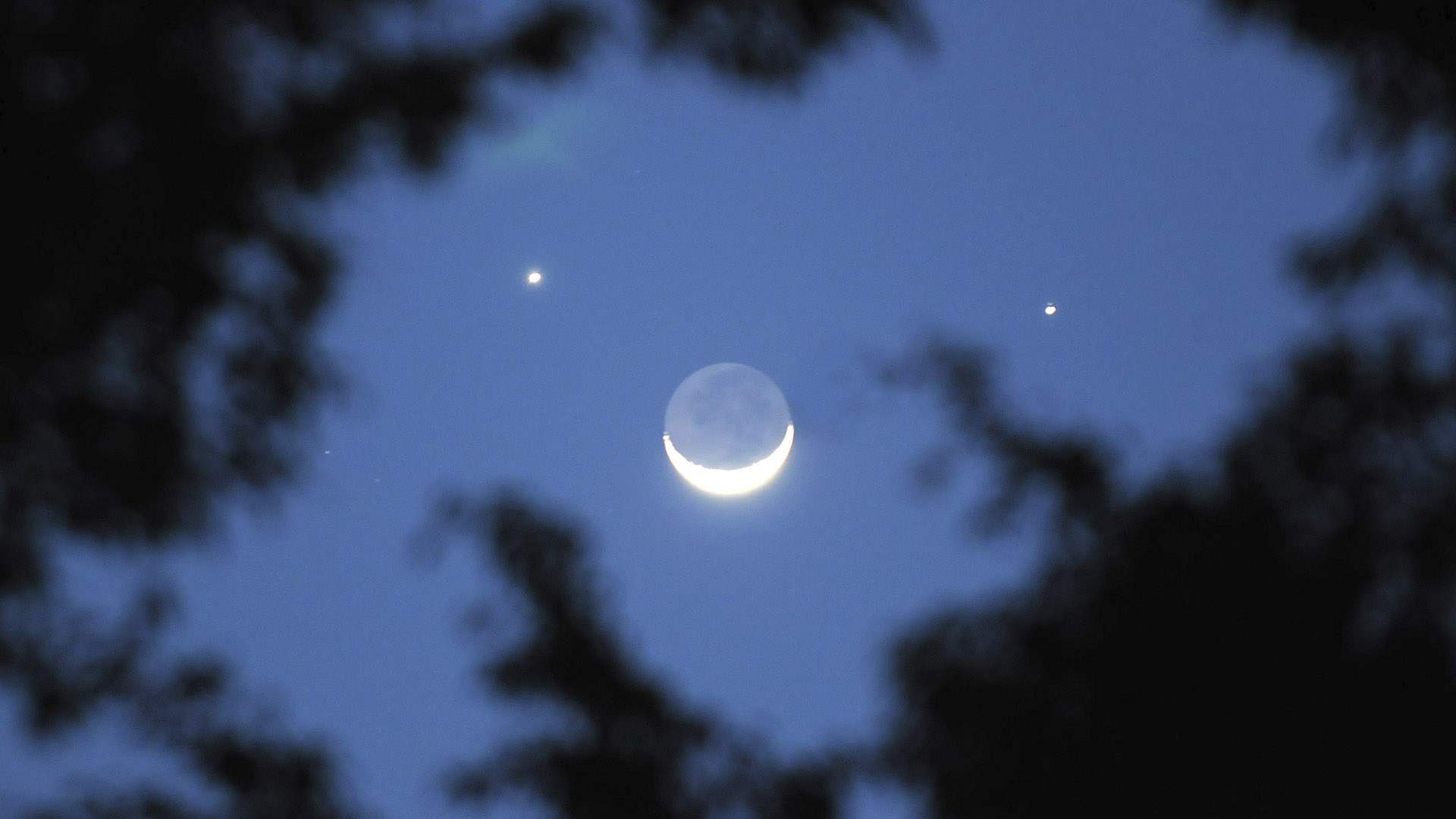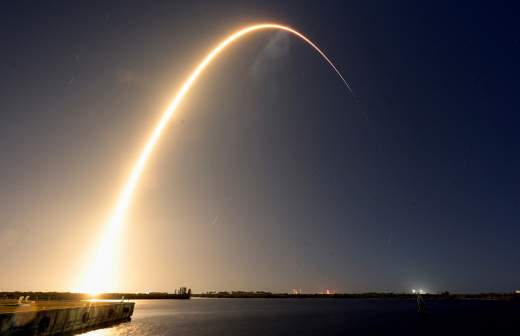- Статьи
- Science and technology
- Planet Yard: Earthlings will see the Star of Bethlehem and Saturn's disappearing rings
Planet Yard: Earthlings will see the Star of Bethlehem and Saturn's disappearing rings

In 2025, there will be a rare conjunction of the disks of Venus and Jupiter, a combination reminiscent of the Star of Bethlehem. There will also be a full parade of planets, two paired solar and lunar eclipses, and two unusual supermoons. In addition, astronomers will be able to see the surface of Mars during its confrontation with Earth, as well as see Saturn's rings "disappear". About these and other significant "celestial" events that will occur this year, read in the material "Izvestia".
What planets will be visible in the sky in 2025
2025 will be rich in unique astronomical events. It began with the passage of comet ATLAS on January 14, which was visible to the naked eye, and at the end of the year is expected incredible "star shower" - meteor stream Geminida with an intensity of 150 meteors per hour. This "Izvestia" told the chairman of the Irkutsk Regional Astronomical Society Pavel Nikiforov.
- The sky at the end of January and in February will be exceptional. In these winter evenings, for about a month, we will simultaneously be able to observe all the major planets of the solar system, with the exception of Mercury. And almost all of them will be present in their brightest incarnation," the scientist said.
In a month, he added, in the sky will be visible seven large planets (except Earth), which orbit our system. This event will occur on February 28, the naked eye will be able to distinguish Mars, Venus, Jupiter and Saturn, and Uranus, Neptune and Mercury - with the help of telescopes.
Also, explained the scientist, until the end of spring, residents of the Northern Hemisphere will be able to study Jupiter in the best position for observation - high above the horizon. This position of the giant planet took for the first time in 11 years and will be available for study until the end of spring. Astronomy enthusiasts will also be able to see Jupiter's satellites and their shadows passing over the planet's surface through telescopes.
Good conditions have developed and for "close acquaintance" with Mars, said Pavel Nikiforov. Since January 16, it has been in opposition - the position in which this planet, the Earth and the Sun line up. During this period , Mars is at a minimum distance from us, and its apparent diameter increases four to five times, so you can see the details of its surface, added the specialist.
Unusual astronomical events
- Of the notable events this year it is worth noting the "meeting" of Venus and Jupiter. The angular distance in the sky between them will be about 0.5 degrees. Convergence can be observed on August 12, 2025. This event will remind of the Star of Bethlehem - when, as scientists believe, the disks of the planets coincided into one unusually bright luminous point, which indicated to the biblical wise men the place of birth of Jesus Christ - explained Pavel Nikiforov.
In addition, on March 23, astronomy fans will be able to see how the famous rings of Saturn "disappear". This visual effect occurs due to a certain angle of inclination of the planet relative to the Earth. Such events occur once every 15 years.
- Spring 2025 will begin with eclipses: total lunar and partial solar - March 14 and 29, respectively. The first of these phenomena will be clearly visible in the Western Hemisphere, and Russians will see only the final penumbral phases of the lunar eclipse in Chukotka, Kamchatka and the Magadan region. The March partial solar eclipse will be best observed in the northwestern regions of our country, - said the expert.
The next pair of eclipses, he said, should be expected in the fall. The lunar one will take place on September 7. In most Russian regions (except for the easternmost) will be clearly visible satellite, which enters and leaves the Earth's shadow. The duration of the full phase will be about 1.5 hours. Partial solar eclipse will take place on the day of the autumnal equinox, September 21. True, this phenomenon can be seen only in Antarctica and its vicinity.
In addition, according to Pavel Nikiforov, of interest are the so-called super moons, in which the satellite is maximally close to the Earth. And at this moment should be a phase of full moon or new moon. The most striking event of this kind will occur on November 5, when the centers of the Earth and the Moon will be at a minimum distance (356,832 km) just nine hours after the full moon. On December 4, the super moon will be repeated, but the Moon will be 129 km farther from the Earth.
At the same time, this year it is worth paying special attention to the "stars that fall from the sky". These are particles of cosmic matter that collide with the Earth's atmosphere and burn in it, leaving a luminous trace. In particular, August 12 will be the maximum of the Perseid flux. As a rule, it is from 20 to 30 meteors per hour. Then, on November 17, will reach its apogee Leonids stream with an intensity of about 15 meteors per hour. On December 14, the Geminid "star shower" will fall on Earth. It is expected that the frequency of "shooting stars" in this stream will be up to 150 meteors per hour. And the conditions for observing this event will be favorable.
Why it is important to watch the stars
- These days, watching the stars is useful not only for amateurs, but also for scientists who seek to explain the causes of phenomena and how they are related to each other- said "Izvestia" director of the planetarium of the Samara National Research University named after Academician S.P. Korolev Irina Feoktistova.
She added that proper astronomical knowledge, in particular, helps to understand the Earth's place in the universe, as well as what is happening to our planet now and what awaits in the future.
To the significant astronomical events of 2025 Irina Feoktistova added the double visibility of Venus. This is an event when the planet, which in different cultures is represented as "morning star" or "evening star", during one day is clearly visible both shortly after sunset and almost before dawn. Such a phenomenon astronomers will be able to observe in the period from March 18 to 21. The next time the double visibility of Venus will be repeated only in 2033.
At the same time it is necessary to separate the actual events from the meaning that they are sometimes given in the media, said the director of the Pskov Planetarium and head of projects ANO CMIT "Young Technician" Vladimir Kolpakov.
- What is called "parades of planets" - a fairly common astronomical event when the planets appear in one narrow segment of the celestial sphere. And it should be understood that this is only a visual effect. In fact, the planets are very far from each other in outer space, - said the expert.
Nevertheless, he emphasized, the observation of the starry sky is not an idle interest. A huge number of scientific and technical achievements are due to the fact that people look up to the sky, strive to reach other celestial bodies and invent various means for this purpose, which are then used also in everyday life. Interest in the sky has led to the development of a large number of scientific fields.
In turn, Deputy Director of the Crimean Astrophysical Observatory on scientific work, Alexander Volvach noted that at the moment there is no scientific confirmation that the planets of the solar system, which are on one side of the Earth, have a noticeable impact on the state of people. The same can be said about other unusual astronomical phenomena.

Переведено сервисом «Яндекс Переводчик»








